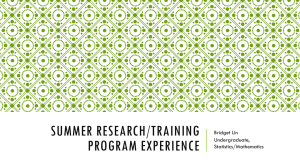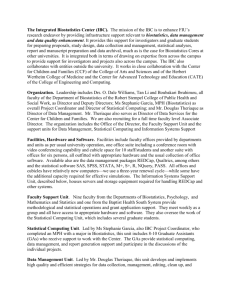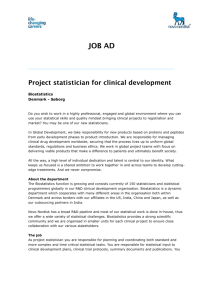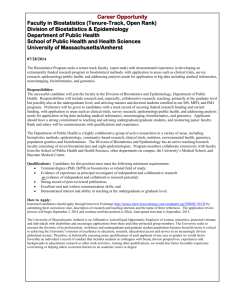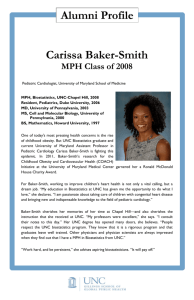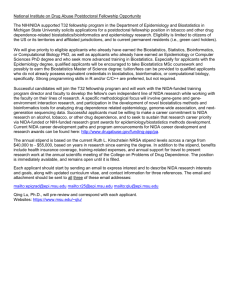MSInfoBSTA - California State University, East Bay
advertisement
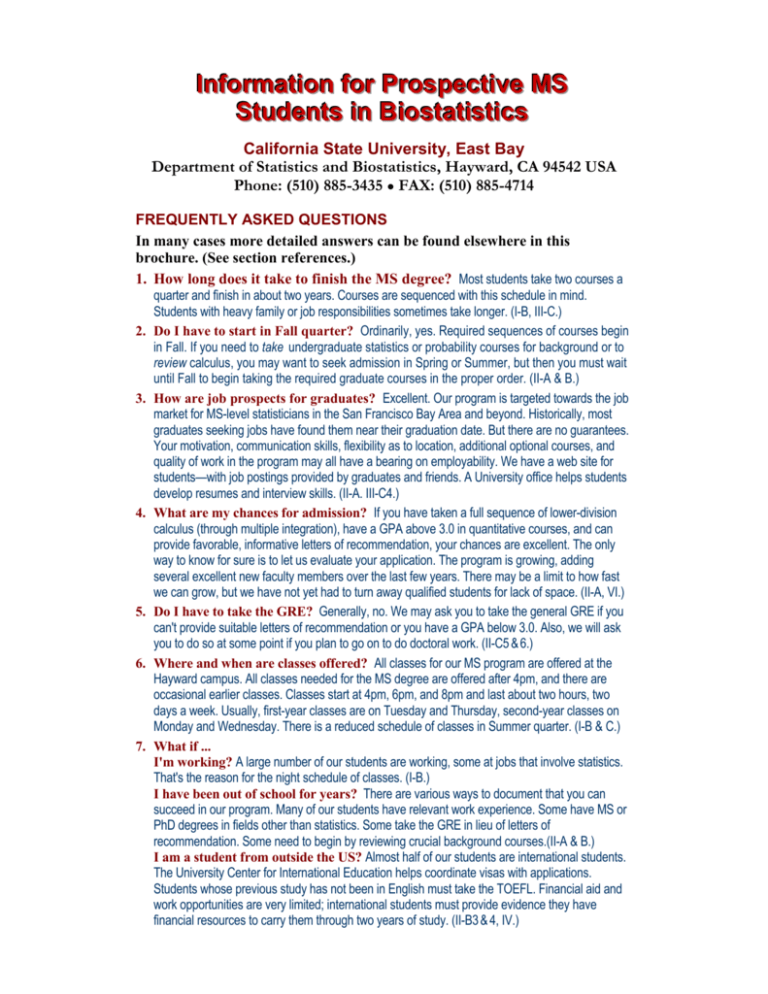
Information for Prospective MS Students in Biostatistics California State University, East Bay Department of Statistics and Biostatistics, Hayward, CA 94542 USA Phone: (510) 885-3435 ● FAX: (510) 885-4714 FREQUENTLY ASKED QUESTIONS In many cases more detailed answers can be found elsewhere in this brochure. (See section references.) 1. How long does it take to finish the MS degree? Most students take two courses a 2. 3. 4. 5. 6. 7. quarter and finish in about two years. Courses are sequenced with this schedule in mind. Students with heavy family or job responsibilities sometimes take longer. (I-B, III-C.) Do I have to start in Fall quarter? Ordinarily, yes. Required sequences of courses begin in Fall. If you need to take undergraduate statistics or probability courses for background or to review calculus, you may want to seek admission in Spring or Summer, but then you must wait until Fall to begin taking the required graduate courses in the proper order. (II-A & B.) How are job prospects for graduates? Excellent. Our program is targeted towards the job market for MS-level statisticians in the San Francisco Bay Area and beyond. Historically, most graduates seeking jobs have found them near their graduation date. But there are no guarantees. Your motivation, communication skills, flexibility as to location, additional optional courses, and quality of work in the program may all have a bearing on employability. We have a web site for students—with job postings provided by graduates and friends. A University office helps students develop resumes and interview skills. (II-A. III-C4.) What are my chances for admission? If you have taken a full sequence of lower-division calculus (through multiple integration), have a GPA above 3.0 in quantitative courses, and can provide favorable, informative letters of recommendation, your chances are excellent. The only way to know for sure is to let us evaluate your application. The program is growing, adding several excellent new faculty members over the last few years. There may be a limit to how fast we can grow, but we have not yet had to turn away qualified students for lack of space. (II-A, VI.) Do I have to take the GRE? Generally, no. We may ask you to take the general GRE if you can't provide suitable letters of recommendation or you have a GPA below 3.0. Also, we will ask you to do so at some point if you plan to go on to do doctoral work. (II-C5 & 6.) Where and when are classes offered? All classes for our MS program are offered at the Hayward campus. All classes needed for the MS degree are offered after 4pm, and there are occasional earlier classes. Classes start at 4pm, 6pm, and 8pm and last about two hours, two days a week. Usually, first-year classes are on Tuesday and Thursday, second-year classes on Monday and Wednesday. There is a reduced schedule of classes in Summer quarter. (I-B & C.) What if ... I'm working? A large number of our students are working, some at jobs that involve statistics. That's the reason for the night schedule of classes. (I-B.) I have been out of school for years? There are various ways to document that you can succeed in our program. Many of our students have relevant work experience. Some have MS or PhD degrees in fields other than statistics. Some take the GRE in lieu of letters of recommendation. Some need to begin by reviewing crucial background courses.(II-A & B.) I am a student from outside the US? Almost half of our students are international students. The University Center for International Education helps coordinate visas with applications. Students whose previous study has not been in English must take the TOEFL. Financial aid and work opportunities are very limited; international students must provide evidence they have financial resources to carry them through two years of study. (II-B3 & 4, IV.) CSU East Bay: Information for Prospective Biostatistics MS Students 2 I. INTRODUCTION The Department of Statistics and Biostatistics at Cal State East Bay (formerly Cal State Hayward) offers graduate study leading to the Master of Science in Biostatistics. This brochure should answer most of your questions about the program. It describes the University and our Biostatistics MS program, and it summarizes application procedures and degree requirements from the Cal State East Bay Catalog. The Catalog in effect at the time you enter the program provides the official statement of your graduation requirements. It is available online: www.csueastbay.edu/ecat/current (entry point for entire Catalog) www.csueastbay.edu/ecat/current/g-bsta.html (MS Program in Biostatistics) In particular, this brochure describes some required procedures for applying to MS programs of the Department of Statistics and Biostatistics that are not included in the Catalog. (See part II-C.) A. Multi-Purpose Program Our admission requirements are flexible enough to accommodate a wide range of backgrounds and interests. Successful graduates have come to the program with undergraduate majors in such fields as mathematics, business administration, political science, computer science, education, economics, and engineering — as well as biology and statistics. Also, it is not unusual for students with MS and doctoral degrees in fields other than statistics or biostatistics to enter the program. Most of our graduates work as applied statisticians in industry or government. Many have moved into managerial roles as their careers have matured. Department contacts with alumni and Bay Area employers enable new graduates to seek opportunities with organizations familiar with the quality of our programs. Our programs are highly respected by employers in the Bay Area and beyond because they provide students with a mixture of practical applied and computational methods, and they also provide enough theoretical background so students can continue to learn new methods after leaving the University. The same contacts with alumni and local businesses that provide our students with employment opportunities also provide our faculty with an opportunity to cooperate with employers in keeping our programs up to date. Faculty make every effort to help students devise programs that meet their individual needs. For example, individually designed programs of study have prepared about 10% to 15% of our MS graduates for PhD work in statistics, biostatistics, and related fields at universities with international reputations. Study at the doctoral level in these areas often requires several mathematics courses beyond calculus. B. Flexible Schedules — For Working or Full-Time Students Because many of our graduate students are also employed off campus, graduate courses are scheduled so that the Biostatistics MS Degree can be completed by taking courses between 4:00 and 10:00 p.m. Most classes related to the program are scheduled for two evenings a week. (Some full-time employers allow flexible work schedules, for example, to permit attending classes starting at 4:00 p.m. on two days a week.) As the program continues to grow, we will offer more afternoon courses and sections, providing greater scheduling flexibility for some students. Most students complete the program within two years. Recently, about 35 students have graduated from our MS programs each year, and the programs are growing steadily. This makes our Department one of the largest producers of MS-level professional biostatisticians and statisticians in the US. CSU East Bay: Information for Prospective Biostatistics MS Students 3 C. Ideal Environment The Hayward campus of Cal State East Bay is located in the rolling foothills on the eastern shore of San Francisco Bay with magnificent views of the Bay Area. The climate is mainly dry from May through October, with rainy periods November through April. Temperatures are mild: freezing weather is rare, and usually only a few summer days exceed 90F (32 C). The Bay Area is a center of much cultural and statistical activity. Stanford University and the University of California, Berkeley and UC San Francisco are all within 40 miles of campus. The San Francisco Chapter of the American Statistical Association has a regular calendar of events. Also, companies in the biotechnology, pharmaceutical, computer, defense, and financial sectors participate in the statistical life of the Bay Area. A modern computer laboratory, equipped with a wide range of statistical software, is available for Statistics classes and for student use outside of class. Important statistical software is licensed for student use off campus. Class sizes are relatively small, usually averaging 30-40 for the beginning courses in the program and often smaller for advanced graduate-level courses. II. ADMISSION TO THE PROGRAM Here is a step-by-step explanation of the admission process. This section explains some procedures required by the Department of Statistics and Biostatistics, but not included in the Catalog. They are intended to ensure that your application for admission receives the most prompt and favorable consideration possible. Step A: Verify Course and Degree Requirements For Admission The following information is provided so that you can assess whether you are eligible for admission to the Biostatistics MS Program. Admission is a two-stage process: (1) Admission to the University as a graduate student, and (2) Acceptance into the Biostatistics MS Program. The only way to know for sure whether you are qualified for admission is for the University and the Department to evaluate your transcripts, letters of recommendation, and other evidence listed below in Steps B and C. However, for applicants who meet the criteria below, the acceptance rate has been very high. Currently, there is no set maximum number of students admitted each year. Departmental Calculus Requirement. The Department absolutely requires a background in mathematics through lower-division calculus. At CSU East Bay, the equivalent courses are MATH 1304, 1305, and 2304. See the latest online Catalog under Undergraduate Programs > Mathematics > Courses for course descriptions. This is “math major” calculus, including infinite series and multiple integrals. Simplified courses, such as those intended for majors in biology and business, are not adequate. About calculus. A solid background in calculus is essential to success in the program. First-year statistics and probability courses in the program regularly use ideas of calculus. If your calculus background is weak (grades below B or taken long ago): (1) review on your own topics you once understood well, but now remember only fuzzily, (2) re-take a course equivalent to our MATH 2304: Calculus III, or (3) re-take the entire lower-division sequence of “math major” calculus. Depending on the degree of your deficiency and your personal schedule, you may be able to handle some of this review during your first year of the program. However, taking the required calculus courses for the first time after admission to the program is not a possibility. CSU East Bay: Information for Prospective Biostatistics MS Students 4 University Degree and GPA Requirements. University requirements for admission to graduate programs include the following: The University ordinarily requires a 4-year baccalaureate degree from an accredited institution. The University target specifies that work taken during your junior and senior years must average B (GPA 3.0) or better. In borderline cases, the Admissions Office sometimes requests an opinion from the Department of Statistics and Biostatistics based on grades in courses in mathematics, statistics, biology and other sciences, on performance in other graduate programs, or on other factors. Additional Helpful Background. Students who have some of the following additional background may be at an advantage for admission to the program and for progress towards the degree after acceptance. Basic statistics and probability courses, especially those requiring calculus as a prerequisite. (Examples: Courses equivalent to STAT 3401, 3502, or beyond. See the Catalog under Undergraduate Programs > Statistics > Courses.) Some students prefer to start the program in Spring or Summer to take these course before beginning their graduate level courses the following Fall. About previous background in statistics and probability. During the first quarter in the program almost all students take beginning statistics and probability courses taught at the graduate level. In addition to theory, these courses contain applied and computational concepts not often found in undergraduate courses. A solid background in calculus is required. But we do not formally require a background in statistics and probability. Of course, students with some previous knowledge of statistics or probability generally have an easier time in these courses and gain a better initial understanding of the deeper concepts. The combination of weak calculus and no previous statistics or probability can cause difficulties. Mathematics courses beyond calculus, especially linear algebra and analysis. (See the Catalog under Undergraduate Programs > Mathematics > Courses— particularly MATH 2120, MATH 3100, MATH 3300, and so on.) Knowledge of a computer programming language (for example, C++ or Java) or experience using statistical software (especially SAS or R) to analyze data. Experience in a setting where studies or experiments result in the collection of data, especially if this has involved writing statistically-oriented reports. Flexibility. Exceptions require clear evidence of your ability and motivation to succeed in our program—where almost all grades must be As or Bs. For example, such evidence may be found in Graduate Record Exam scores, recent coursework, relevant work experience, and informative letters of recommendation. (However, there is no exception to the departmental calculus requirement mentioned above.) Step B: Application for Graduate Admission to the University (Send to Admissions Office) Deadlines. Students are admitted to the Biostatistics MS Program starting in Fall quarter (beginning late September) and must immediately begin taking the sequences of graduate courses in the intended order. However, as mentioned above, if you want or need additional background courses before starting your graduate study, you might start in Spring quarter (mid-March) or Summer quarter (mid-June). The range of course offerings is not as great in Summer as in other quarters. Your application and transcripts should arrive at the Admissions Office before the application deadline date for the quarter in which you intend to enter the program. For some programs, including the Biostatistics MS Program, deadlines for application have sometimes been extended beyond the published dates. If you miss a deadline, do not assume that applications are closed without asking. CSU East Bay: Information for Prospective Biostatistics MS Students 5 1. APPLICATION FORM. Apply for graduate admission to the University by completing the appropriate web form. Follow the instructions at www.csumentor.edu/AdmissionApp . Be sure to: (1) indicate East Bay as your choice of campus and Biostatistics as your proposed MS major, (2) complete all parts of the application (including the questions used to determine residency status for tuition purposes), and (3) pay the required processing fee. There are no options in the Biostatistics MS Program. Keep a copy. You should keep a copy of the contact information, academic history, and list of references you give on your application because you will also need these items for the information packet required by the Department of Statistics and Biostatistics (see Step C). Please let us know if there are any changes. (One way to capture this information is to make a printout of your online application.) Separate Statement of Purpose. There is not enough room on the online application form for a statement of purpose of the kind required by the Biostatistics MS Program. On the application form indicate that your statement of purpose has been “Sent to the Department of Statistics and Biostatistics.” 2. TRANSCRIPTS. As soon as you submit your application, arrange to have official transcripts sent to the Admissions Office by all colleges and universities you have attended. Your application to the University will not be processed until all your transcripts have been received. Late-arriving transcripts are a major cause of delayed admissions. 3. Required of all foreign-language applicants: TOEFL SCORES. If your undergraduate degree is from a place where English is not the principal language of instruction, you must complete the TOEFL (Test of English as a Foreign Language). The lowest acceptable score is 550 (or 213 for computer-based or 79 for internet-based tests), but higher scores are preferable. Have scores sent to the Admissions Office. 4. Required of all non-US applicants: AFFIDAVIT OF SPONSORSHIP OR EVIDENCE OF FUNDS. The Department of Statistics and Biostatistics welcomes students from outside the US, and many international students have done excellent work in our program. However, neither the University nor the Department has funds to offer international students for financial aid or scholarships towards tuition, academic expenses, or living expenses. Permission to work in the US is difficult to obtain because of immigration restrictions. Students who are not citizens or permanent residents of the US can be accepted at Cal State East Bay only with evidence that they have funds available to cover all educational and living expenses for the length of time necessary to complete the degree. International students must also be covered by a health insurance policy during their time at the University. For more specific information and the required forms, see www20.csueastbay.edu/prospective/how-to-apply/international-studentadmission/index.html . Depending on educational background, it has been our experience that most international students take about two years to complete the Biostatistics MS Program. Step C: Information on Qualifications for MS in Biostatistics (Send to the Department) Please send all of the following information and documentation in a single package to the Department of Statistics and Biostatistics—not to the Admissions Office. Address your package to: MS Biostatistics Admissions, Department of Statistics and Biostatistics, CSU East Bay, Hayward CA 94542, USA. CSU East Bay: Information for Prospective Biostatistics MS Students 6 1. INFORMATION FROM YOUR APPLICATION. In this package, please include the following information: (1) your desired starting quarter, (2) your contact information (postal address, telephone, email address), (3) your academic history (institutions attended, dates, degrees), and (4) a list of your references. You can give us a copy of your web application or type this information on one page. 2. UNOFFICIAL COPIES OF TRANSCRIPTS. In this package, please send original or readable photocopies of transcripts. (This is in addition to the official transcripts you order sent to the Admissions Office.) Some universities make it possible for you to access your courses and grades online; a clear printout of such an online list is acceptable provided it is accurate and up to date. If a transcript from an institution you attended does not show your grade point average (GPA) in the US system (A = 4.0, B = 3.0, and so on), then provide this GPA information as an attachment. If you do not know the equivalent GPA, explain the grading system briefly. (For example: What is the lowest passing grade in a course? The average grade necessary for graduation? The average grade necessary for honors?) 3. COURSE LISTS. Separate from your transcripts, please make an organized chronological list of your previous work in mathematics, statistics, and related quantitative courses, and include it in the package for the Department Office. Calculus-prerequisite courses (no exceptions). Provide a clear statement of how and where your basic calculus prerequisite was met. Give course names, dates, grades (converted to the US grade system, if necessary), institutions, and brief course descriptions. This information must be precise so that we can verify on your transcript(s) that our calculus requirement has been met. List of other relevant courses. If you have taken any post-calculus courses in statistics, mathematics, or related fields, please give us a list with dates, grades (in the US system: A, B, C, etc.), and, if known, instructors and textbook authors. Courses such as Math 3100: Linear Algebra or Math 3300: Analysis I are of particular interest. (For course descriptions see the Catalog under Undergraduate Programs > Mathematics > Courses.) 4. STATEMENT OF PURPOSE. Please include in your package a straightforward statement of about 1.5 pages in length discussing your background (especially academic), career objectives (to the extent known), and reasons for seeking an MS Degree in Biostatistics. If you believe that your transcripts or past grades do not accurately represent your current ability to perform to a high standard in the Biostatistics MS Program, please provide an explanation. Especially if your GPA is below 3.0, you need to convince us that you can succeed in a program in which you will be expected to get no grades lower than B. This Statement of Purpose must be provided directly to the Department of Statistics and Biostatistics—not included in your online application. 5. LETTERS OF RECOMMENDATION. If possible, include letters of recommendation as part of your packet (preferably in envelopes sealed by their authors). Normally, we require at least two, preferably three, letters of recommendation from people who are familiar with your academic background in mathematics, statistics, or other quantitative courses, and who can provide informative assessments of your aptitude for graduate work. These should correspond to the references named on your application form. If your references prefer to send letters separately, please request that they be sent to MS Biostatistics Admissions, Department of Statistics and Biostatistics, CSU East Bay, Hayward CA 94542, USA—with the notation “Letter of Recommendation” in the lower-left corner of the envelope. There is no special form for submitting letters of recommendation. A gap in your studies? We realize that some applicants will seek to enter the program some years after their previous degree work was completed, and so academic references may be difficult to obtain. If you cannot provide at least two recent, informative, and CSU East Bay: Information for Prospective Biostatistics MS Students 7 relevant academic letters of recommendation, then please take the general GRE and have the scores sent to the Department (see below). Usually, recent means within five years, informative means providing assessments beyond what is obvious from a transcript, relevant means based on performance related to statistics or mathematics, and academic means based on coursework at a university. 6. GRADUATE RECORD EXAM (GRE) SCORES. We do not require GRE scores of all applicants. However, in any of the following circumstances, we ordinarily require scores for the General GRE (Verbal, Quantitative, Writing): If you cannot supply at least two academic letters of recommendation as explained in Section 5 above. If your average GPA in any of the following categories is below B (3.0): (a) All of your undergraduate work, (b) All of our courses in the mathematical sciences (including statistics and computer science) at the undergraduate level, (c) All of your post-baccalaureate work at any one institution. If you intend to pursue PhD work after earning your MS degree. In evaluating you for admission to the Biostatistics MS Program, the Department will consider GRE scores along with your previous grades, letters of recommendation, and statement of purpose. In addition to providing important information for admission, GRE scores can be useful for advising students once they are admitted to the program. Also, a score of 4.5 or better on the writing part of the General GRE satisfies the University Writing Skills Requirement (see part III-A below). Last-minute GRE? If GRE scores are available at the time you submit your packet to the Department, include a photocopy of the GRE report in your packet, and have your official scores sent to the University separately (Institution Code 4011). But do not delay your application waiting for GRE scores. If scores are not available when you send your packet, please have official scores sent to the University as soon as they are available. (Usually, upon finishing the GRE, you are given estimated scores. Please report these unofficial estimated scores to the Department Office, in terms of both points and “percent below,” and let us know approximately when to expect official scores.) III. DEGREE REQUIREMENTS Here we give brief, informal summaries of the degree requirements. For official information on specific requirements, consult the University Catalog. (In the online Catalog for the academic year of your admission, or most recent re-admission, to the program, select Graduate > Statistics.) Requirement A: University Writing Skills Requirement (UWSR) The Writing Skills Requirement is intended to make sure students can express themselves effectively in written English both during their degree work and after graduation. It is satisfied by taking the Writing Skills Test (WST) administered by the University during the first quarter of residence in the program and, if necessary, by taking one or two designated English composition courses. In order to continue in the program, you must complete this requirement, and your status in the program will be “unclassified” until you do so. (See the Catalog for more information on the UWSR as it applies to graduate students.) Sufficiently high scores on certain standardized tests may be used in place of the WST. See www.testing.csueastbay.edu/uwsr/uwsrexempt.php for information. If you have already satisfied the Writing Skills Requirement as a graduate or undergraduate student at any California State University, you need not do so again. CSU East Bay: Information for Prospective Biostatistics MS Students 8 Requirement B: Unit and Grade Requirements The minimal unit and grade requirements are as follows: The Biostatistics MS Program consists of at least 48 quarter units of approved upper-division and graduate work. At least 44 of these units must be approved graduate (6000 level) courses. All work applied toward the 48 units must be at an average grade of B (3.0) or higher, and no required graduate-level course may be at a grade below B− (2.7). However, depending on mathematics and statistics background before entry into the program and career objectives upon graduation from the program, many students will need or want to take more than 48 units to finish the program. (Taking approximately 12 additional units is not uncommon.) Requirement C: Course Requirements This is an abbreviated statement of course requirements. (For the full and official lists of courses, see the online Catalog at: www.csueastbay.edu/ecat/current/g-bsta.html#section3 ). All courses to be submitted towards the Biostatistics MS must be approved by a graduate advisor in advance of registration. A recent list of course offerings by quarter may help you to plan your schedule of classes. (See: www.sci.csueastbay.edu/schedule/current/stat.shtml ). 1. FOUNDATION COURSES. All entering students will have taken a full sequence of lower-division calculus courses before entry into the program. However, especially if you took calculus several years ago, you may need to re-take one or more calculus courses early in the program. Many entering students will have taken previous courses in statistics or probability. Strictly speaking, the normal first-year graduate courses in probability and statistics do not require any probability and statistics as prerequisites. However, if you have little or no previous background in these subjects, you may feel more comfortable taking an upper-division course in probability or statistics before you begin the corresponding graduate courses (see the online Catalog at: www.csueastbay.edu/ecat/current/u-stat.html#section9 ). Neither calculus review courses nor upper-division probability or statistics courses count towards the 48-unit requirement for the Biostatistics MS Degree. 2. REQUIRED FIRST-YEAR GRADUATE-LEVEL COURSES. Required firstyear graduate courses (usually offered on Tuesdays and Thursdays) include statistical theory, statistical programming, experimental design using the analysis of variance, theory and applications of regression, probability theory, and advanced statistical inference based on probability theory. 3. REQUIRED SECOND-YEAR GRADUATE-LEVEL COURSES. Required second-year graduate courses include advanced probability, two courses in mathematical statistics, and three courses specific to the Biostatistics MS: categorical data analysis, survival analysis, and clinical trials. 4. ELECTIVE COURSES. Students entering the program with equivalents of some of the above courses may select, with an advisor’s consent, additional graduate-level courses, to meet the minimum requirement of 48 units overall. Also, some students may elect to take more than 48 units. CSU East Bay: Information for Prospective Biostatistics MS Students 9 Some possible topics of these substitute or additional courses include: stochastic processes, multivariate analysis, time series analysis, Bayesian statistics, co-operative education, and occasionally-offered courses on special topics in graduate biostatistics, statistics, or probability. In addition, it is strongly recommended that students who plan to apply for doctoral studies in statistics, biostatistics, or public health take mathematics beyond the requirements for the MS in Biostatistics, including courses in analysis and linear algebra. Requirement D: Comprehensive Examination The MS Comprehensive Exam tests for general knowledge of the fields of statistics and probability and an understanding of methods of application to “real world” situations—including the use of statistical software such as Minitab, SAS and R. General information about the courses and material covered is provided in advance of each offering of the MS Comprehensive Exam. In order to take this exam, students must be in good academic standing and no more than 12 units short of finishing their degree requirements. IV. FINANCIAL AID The Catalog describes various loans and scholarships that are administered by the University. You can obtain additional information from the Financial Aid Office. Within the Department, a few possibilities for limited financial support may be available for students who have proved their ability to do good work in the program. Department Graduate Assistantships. The Department has a limited number of graduate assistantships (approximately $500 per quarter; grading for professors, etc.). Selected students who have already been in the program for at least one quarter are hired for these positions. The main selection criteria are quality of work in the program, suitability for the tasks required, and financial need. No teaching assistantships are available. Internships. In recent years, a few paid internships (course credit for on-the-job experience) have been available for advanced students. Usually, students make their own arrangements for internships in an area of personal interest, often with present or possible future employers. Department Scholarships. Several scholarships (usually $500 or more) have been established through the generosity of alumni, faculty, staff, and friends of the Department. See www.sci.csueastbay.edu/statistics/scholarships.shtml for details. International Students. For many years, the Department has welcomed students from countries around the world. But students who are neither citizens nor permanent residents of the US must provide evidence of financial sponsorship or of their ability to meet all tuition and living expenses from their own resources. (See II-B-4 above.) V. FURTHER INFORMATION If you have questions not answered here or in the university Catalog, you may contact the Department. (Please see the contact information at the beginning of this brochure.) The Department Chair can be reached by email at eric.suess@csueastbay.edu. For the quickest, most relevant response, please begin the subject line of your email with STAT-MS=Inquiry and provide brief information about citizenship/ residency/ visa status and prior degrees/ dates/ GPA along with your questions. CSU East Bay: Information for Prospective Biostatistics MS Students 10 VI. GRADUATE FACULTY T. Lynn Eudey (PhD 1988, University of California, Berkeley). Biostatistics, experimental design, survey sampling, clinical trials. Graduate Advisor. Shenghua Kelly Fan (PhD 1999, University of Minnesota). Biostatistics, experimental design, Bayesian statistics, biostatistics, survey sampling. Joshua Kerr (PhD 2006, University of California, Davis). Time series, computational statistics, Bayesian statistics. Julia Norton (PhD 1977, Harvard University). Multivariate analysis, statistical computing. Eric Suess (PhD 1998, University of California, Davis). Time series, Bayesian statistics, statistical computing, statistical consulting. Department Chair and Admissions Advisor. Bruce Trumbo (PhD 1964, University of Chicago). Probability theory, applied statistics, biostatistics, simulation, bibliography of statistics, statistical graphics, use of computers in statistics education. Graduate Coordinator. Mitchell Watnik (PhD 1996, University of California, Davis). Econometrics, statistical consulting, statistics education. YanYan Zhou (PhD 1996, University of Maryland, Baltimore). Biostatistics, categorical data analysis, time series. BT Last modified: 8/2009
